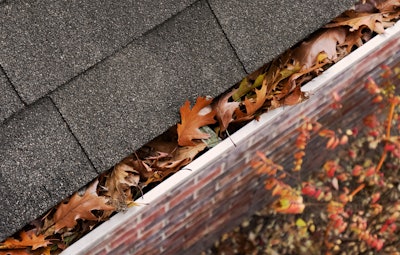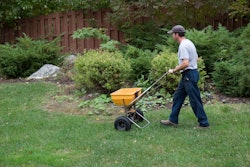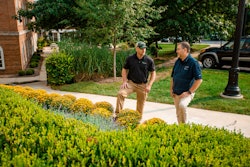
If you are a landscape professional that offers holiday light installation, then you can really benefit your clients by looking out for some of these common issues that become apparent when hanging lights. While the biggest issue is usually looking for that frustrating burned-out bulb, there are also important home repair issues that can be discovered during the process.
Here are the top seven that should be on your radar. Keeping these in mind will not only benefit your clients but could enhance the safety of your crews.
After all, hanging lights and working with electricity can pose some risks.
1. Electrical outlet problems
Electrical issues are usually the first problem discovered when hanging light strings. Outdoor outlets are exposed to the elements and could be more likely to become damaged. For example, a ground fault circuit interrupter (GFCI) may have been tripped if a mouse chewed through a wire or the circuit came in contact with water.
Follow all safety tips if you think there could be a problem with your outlets. A loose connection or exposed wiring could result in an electric shock.
2. Circuit breaker issues
When installing an outdoor light display, you or your crews may also discover issues with the home's electrical system or circuit breaker box. Again, take electrical issues seriously, and remember those circuit breakers are an essential safety system that can help to avoid an electrical fire.
You may want to look at their breaker box before installing holiday lights. You may discover that you need a diagram of which circuits are connected to which outlets or appliances. This can help you avoid overloading a single circuit.
You can also do the math to find out how many strands of lights can be plugged in together without overloading your circuits. Remember that LED Christmas lights generally use less electricity, helping you avoid blown fuses.
3. Overgrown shrubs
While working on light hanging, you may also discover foliage problems as you start to maneuver next to the exterior of the house.
We all know that plants should be at least two feet from a house to protect its foundation. However, until you set up a ladder to work on your client's holiday lights, you might not realize how overgrown the plants around the home have become.
If you discover overgrown shrubs, you might want to suggest that your clients consider bringing you back from some pruning in the early spring.
4. Issues with the roof or gutters
If you're using a ladder to hang Christmas lights, you'll be able to get a close look at your clients' roofs and gutters, and you could notice home issues that you didn't see while on the ground.
When on the ladder, you may discover that gutters are not catching rainwater, causing a situation where rainwater could be pooling right next to the foundation. You could also discover missing shingles on the roof or a sagging roof, two other indications that the home could be at risk for water damage.
No matter what damage you discover while on the ladder, it's a good idea to avoid additional damage by using light clips on the edge of your gutter while hanging Christmas lights.
If you offer gutter cleaning, this is a great opportunity to promote these services.
5. Chimney starting to tilt or separate from the home
When installing holiday lights, you may also discover that the chimney or potions of the house may be out of plumb or starting to tilt. These are just a couple of signs of foundation problems.
The classic way to test this is to hold a string with a small weight on it from the top edge of the house. Because the string will always fall straight downward, you can easily determine if there is a tilt to a portion of the home. For a tilting chimney, you may even start to see a visible gap where the chimney is pulling away from the remainder of the house.
Discovering this type of tilting can indicate that your client's home is settling unevenly or sinking into the ground. Because a settling foundation can affect the essential load-bearing structure of the home, this is not a DIY repair for homeowners. You'll want to suggest that your clients talk to a foundation expert.
6. Pest damage
While hanging light strands on a home, you may also discover pest damage. The signs and location will vary by type of pest. Along the eaves, you could find woodpecker holes or wasp nests. Where the house meets the ground, you could find signs of termites or ants. If you don't offer pest control services, you'll want to recommend that your client speak to an expert.
7. Siding damage or wood rot
When hanging lights, you may also notice deterioration, damage, or wood rot on the siding or window frames. This means the home could be vulnerable to water damage.
In the warmer months, a home could be unprotected from heavy rains, resulting in flooding or moisture in basements and crawl spaces. As the weather turns cold, the damaged siding could allow water inside the walls, cracking the concrete when it freezes.
Your clients should start repairs by replacing rotted wood and fixing the siding. They may also benefit from the additional water protection of basement waterproofing or crawl space encapsulation.
Added value
At the end of the day, while you are not there to inspect their home, you provide your client with added value by looking out for these issues. If they are never up on a ladder, they might have no idea these issues exist.












